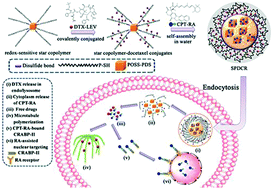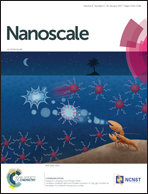Subcellular co-delivery of two different site-oriented payloads for tumor therapy†
Abstract
Co-delivery of multiple agents via nanocarriers is of great interest in cancer therapy, but subcellular delivery to the corresponding site of action remains challenging. Here we report a smart nanovehicle which enables two different site-oriented payloads to reach their targeted organelles based on stimulus-responsive release and nucleus-targeted modification. First, all trans retinoic acid (RA) conjugated camptothecin (RA–CPT) was loaded in a polyhedral oligomericsilsesquioxane (POSS)-based core; docetaxel (DTX) was grafted on N-(2-hydroxypropyl) methacrylamide (HPMA) copolymers. The POSS core grafted with semitelechelic HPMA copolymers then self-assembled into micelles. Once internalized into the cell, the two drugs were unleashed environment-responsively, and nuclear targeted RA remarkably facilitated the nuclear transport of CPT. Compared with single drug-loaded micelles, the dual drug-loaded platform showed superior synergic cytotoxicity, which was further strengthened by the involvement of RA. The ability to induce DNA damage and apoptosis was also enhanced by nucleus-targeted modification. Finally, dual drug-loaded micelles exhibited much better in vivo tumor inhibition (87.1%) and less systemic toxicity than the combination of single drug-loaded systems or the dual drug-loaded micelles without RA. Therefore, our study provides a novel “one platform, two targets” strategy in combinatory anti-cancer therapy.



 Please wait while we load your content...
Please wait while we load your content...